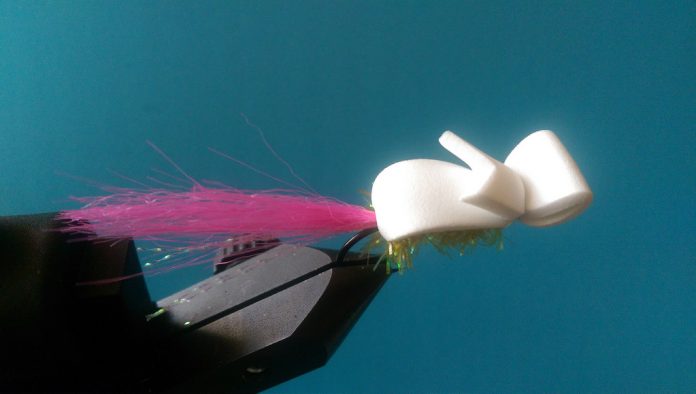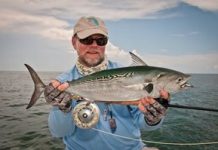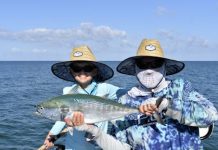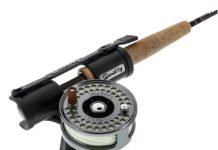By CAPT. PAT DAMICO
Think back to some of your first experiences fly fishing. What were the things about those days that kept your enthusiasm and interest all this time? I would bet that your excitement centered around adventures on a pond, or small freshwater lake. I know mine did. It didn’t begin with a fly rod, but as soon as I began to become a successful fly fisherman it was because I fooled some panfish with a fly. Ponds are readily available in most areas and generally have a variety of fish eager to gulp a small offering. The most innocuous looking one could be a bonanza. Most can be fished from shore so a boat or paddle craft isn’t needed. Panfish are usually not very selective and pound for pound will put a serious bend in your fly rod.
There is no better way to introduce a newcomer, regardless of age, to the joys of fly fishing. How do we get started? Equipment can be very inexpensive. A four weight fly rod eight feet in length with a reel that will hold a floating weight forward fly line and fifty yards of backing is ideal. You will probably never see the backing, but a full spool makes the reel work more efficiently. Reel drag should be reasonably smooth. A seven and a half foot leader tapered to six pound test will get us off to a good start. How about fly selection?
Fortunately, panfish are not very particular. I prefer catching these scrappers with offerings that float. Your local fly shop should have a good assortment of small poppers that come in a variety of shapes, colors and sizes. If you tie your own, Google panfish poppers and find some that are very simple to construct for a few pennies. Poppers are so called because they make a popping noise and disturbance when twitched. The design will usually have a flat face. This will call anything interested in an easy meal to your fly. There are also floating bug imitations that slide through the water without making much surface disturbance. Appropriately called sliders, they create a “V” shaped wake when moving through the water’s surface; a Sneaky Pete would be an example. A pointed forward surface design doesn’t disturb the water the way a popper does. There will be times when one will outfish the other. Favorite colors are white, yellow and black, or combinations of these. Sizes will vary from twelve to six, depending on the size of what you see on the water and also the size of the fish you are pursuing. A large bass will hit a small fly when presented properly. Catching large fish with light tackle is always unexpected extra fun. 
How do we present our floating fly? Unlike saltwater, a slow patient presentation will be more successful than an aggressive one. When fishing a pond, cast parallel and close to shore unless there are some obvious structures like a log, sand bar, rocks or noticeable beds. Cast close to and under docks and bridges. A fly landing with a splat can be more effective than one that lightly touches the surface. Calm water usually demands a quieter more subdued presentation than a surface rippled by the wind. The old rule to wait until the circles made by the fly hitting the water disappear before giving the first small movement is a good one. Your line should be free of slack so that your slightest movement with the line hand will be transmitted to the fly. A quick strip with your line hand will elicit a bubble producing surface “pop.” Wait a few seconds before moving the fly again. Most strikes will come when the fly is sitting still. A slight hesitation, before setting the hook, is needed when you see the fish take the fly; otherwise you will miss a lot of fish. A line that starts to sink will affect the fly’s action as well as prevent you from making a quiet pickup while beginning your next cast. I have been using a product called Zipcast. It is one of the best, and easiest to use floatants, protectors, cleaners and lubricants for fly lines that I have seen in years.
Early morning and evenings will have fish looking for food, generally close to shore. When the sun is up, fishing in shaded areas will be most productive. These areas are more comfortable for the fish we seek. The overhead cover also harbors insects and bugs that drop into their feeding zone.
Keeping some of these fish will generally improve the fishery; accelerating growth rates of the ones that remain. If you enjoy fresh fish fillets, panfish are superb. The skinless fillet can be coated with cornmeal, or your favorite coating. All purpose pancake batter made with beer is hard to beat.
Check out some of the freshwater ponds, or lakes close to home. A rigged fly rod can be put into service in a few minutes on your way from work or any other time that you want to have some instant action and a great diversion. Panfish and surface offerings will remind you why fly fishing is so much fun!
Capt. Pat Damico, a FFF Certified Fly Casting Instructor, guides in lower Tampa Bay as well as surrounding water offering fly and light tackle trips. He can be reached at 727-504-8649, or through his website www.captpat.com where more information is available.
- Captain’s Corner:Pat Damico - June 25, 2019
- Flat water makes seeing tarpon easier - May 17, 2017
- Warm rivers holding plenty of targets for fly fishermen - February 16, 2017











